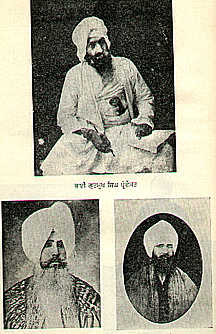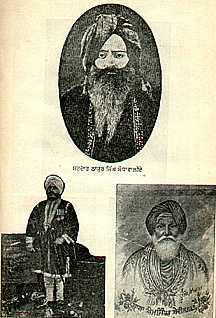

Bhai Gurmukh Singh (top). Giani Dit Singh (left) & S.Jawaher Singh Kapur
A change occurred because of a fundamental cleavage within the Singh Sabha. It came about because a deep division emerged within the movement and because one of the opposing groups won a convincing victory over the other.
The original founders of the Singh Sabha movement were Sanatan or 'traditional' Sikhs, believing that the Panth certainly consisted of the followers of the Gurus but regarding it as a part of wider Hindu society. For the Sanatan Sikhs there was abundant room for variety within the Panth. Those who were not Khalsa members and who did not regard the Rahit as mandatory were just as entitled to call them-selves Sikhs as the Khalsa variety. Notable amongst the early Singh Sabha leaders were Prof. Gurmukh Singh and Giani Dit Singh, both of them members of the Lahore section. Gurmukh Singh was a professor at Oriental College in Lahore and Dit Singh, who proved to be a particularly prolific writer, was a Sikh of outcaste origins. Their backgrounds and interests help to explain the objectives of the Singh Sabha movement and also the methods, which it employed. The dominant objective was the reconstitution of the Panth as the dedicated casteless society intended by the Gurus. The means to this end were to be preaching, education, social reform and literature
A meeting of some prominent Sikhs was held under the Presidentship of Sardar Thakur Singh, as a result of the deliberation of which an association called Sri Guru Singh Sabha came into being on October 1,1873 AD:
The Sanatan Sikhs, who were identified with the original Singh Sabha founded in Amritsar in I873, were opposed by a much more radical opinion centered on Lahore. The radicals were Sikhs of the Tat Khalsa, the 'True Khalsa'. For the Tat Khalsa it was impossible to be both a Hindu and a Sikh, as those of the Sanatan persuasion maintained. The only correct style for a Sikh was that of the Khalsa, and although they did not actually cast out the non-Khalsa variety, they explicitly adopted the view that these non-Khalsa Sikhs were on their way to becoming Sikhs in the full sense of the term. In other words, they were said to be aspiring to become members of the Khalsa. The term Sahaj-dhari, which had long been applied to those who refrained from accepting the Rahit, was reinterpreted to mean 'slow-adopting'. According to this new interpretation, they were Sahaj-dharis in the sense that they were 'slow' in adopting the Rahit, but eventually they would certainly reach this objective.
During the last two decades of the nineteenth century and the beginning of the twentieth, these two groups vigorously contended for the interpretation of what it meant to be a Sikh. The Sanatan Sikhs maintained that variety was entirely permissible in the Panth and that the Panth merely marked out the Sikhs as a special group in Hindu society. In reply, the Tat Khalsa vigorously upheld the view that Sikhs emphatically were not Hindus. They also insistently asserted that the Khalsa mode was the one mode that all Sikhs either accepted or else made their ultimate objective. Ultimately victory went to the Tat Khalsa, and since the early years of the twentieth century Sikhs have been progressively learning three things. First, Sikhs are not Hindus. Secondly, Khalsa membership should be the objective of all Sikhs. Thirdly, Khalsa membership requires obedience to the Rahit.
When the British annexed the Punjab in 1849, they pushed through radical measures for the economic advancement of the area, concentrating on such things as improvements in communications and the extension of the canal system. They also encouraged education, giving aid to missionary schools set up in the province. A common British was that Sikhism was bound to 'merge back into Hinduism', for the British could perceive what they interpreted as abundant evidence of Khalsa decay. What this meant was that they were mistaking the more prominent kind of Sikhs for the whole of the Panth. It seemed obvious to them that there were plenty of signs of an indifferent observance of the Khalsa Rahit and many of them drew the conclusion that this must spell the end of Sikhism.
This, however, had always been the case. Around 1860 or 1870, at the time when these observations were being made, many of those who lived in the villages were very relaxed about questions of identity. Muslims might be easier to distinguish, but the difference between Hindu and Sikh was much more difficult to discern. Although this was somewhat simpler in urban areas, the villages were where a large majority of the Sikhs actually lived. It seemed that only in the Indian army were the Khalsa symbols adequately maintained, the British requiring all Sikh recruits to observe them scrupulously.
Some Sikhs shared this opinion held by the British. Sikhism, they reasoned, had been sufficiently protected under the Sikh Kingdom, but with the annexation of the Punjab in 1849 the Panth had slipped into a condition of indiscipline and negligence. Something must be done. A group of prominent Sikhs convened a meeting in Amritsar in 1873 and after a series of subsequent meetings decided to found a society called the Singh Sabha. The decision was a very important one.
There were two immediate reasons for the action. One was an incident involving the Namdhari sect of Sikhs in 1872, which threatened to damage relations between respectable Sikhs and the British. The other was the news that four Sikh students of the mission school in Amritsar had announced their intention of converting to Christianity. Both were clear indications of the Sikh decline in spirit and devotion, or so it seemed to the Sikhs who participated in these meetings. Among those who attended were members of the old Sikh elite (men such as Khem Singh Bedi, a direct descendant from Guru Nanak), together with affluent landowners, scholars and religious leaders. These were the founders of the new movement, an association, which gave expression to their distinctive ideals.
The founders of the first Singh Sabha were predominantly conservative Sikhs, concerned to sustain and protect the society in which they had been nurtured. This was a society which permitted a variety of Sikh identities, different modes of worship (which included the worship of images), an emphasis upon caste and close ties binding Sikhs and Hindus together. They came, as a result, to be termed Sanatan Sikhs the 'traditional' Sikhs. In the programme they devised particular emphasis was laid upon the promotion of periodicals and other appropriate literature, their assumption being that those who needed to be influenced would be accessible through the printed word. British officers were invited to associate with the Singh Sabha and matters relating to government were expressly excluded from its range interests. The first Singh Sabha was an organization of the upper classes, very similar to the urban associations emerging in other parts of India but specifically concerned with issues affecting the Sikh Panth. .